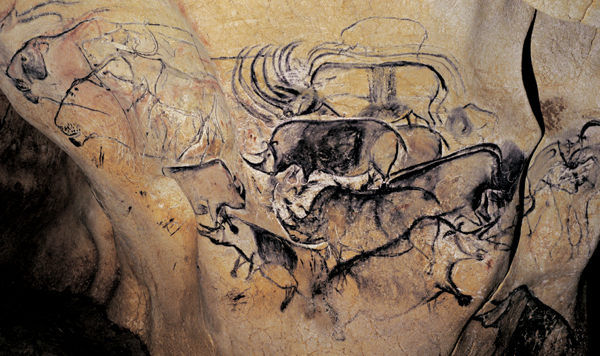Movie review by Greg Carlson
Inspired by Judith Thurman’s lovely 2008 feature in “The New Yorker,” Werner Herzog’s “Cave of Forgotten Dreams” documents the astonishing artwork adorning the walls of France’s Chauvet Cave, the site of the world’s oldest known representational painted images. Discovered by a trio of speleologists in 1994, the Chauvet illustrations – a breathtaking menagerie of more than a dozen species including lion, ibex, bison, horse, owl, bear, hyena, rhino, and mammoth – shattered all previously held records concerning the earliest efforts by human cave artists. By comparison, the famous Lascaux paintings are roughly half the age of the Chauvet work, which has been carbon-dated to a pair of creation periods some 30,000 and 35,000 years ago.
As usual, Herzog makes his presence felt, indulging his considerable curiosity, narrating the movie and appearing in scenes alongside his small crew. Herzog describes in detail the restrictions imposed by the French government on the filmmaking process. Clothed in contaminant-free suits, the moviemakers were confined to a narrow metal catwalk and granted access to Chauvet for only four hours on each of six total days. In addition to Herzog, several of the cave’s principal researchers appear, including Jean Clottes, whose work on shamanic practices designed to contextualize prehistoric cave art has met with fascination and controversy.
Why did Paleolithic artists almost never draw men, women, and children? “Cave of Forgotten Dreams” does not speculate but highlights what has been dubbed “The Venus and the Sorcerer,” a picture of the lower anatomy of a human female partnered or intertwined or layered or combined with a “man-bison” figure. Painted in a place of prominence and privilege on a limestone cone in the Salle du Fond, the final and deepest of Chauvet’s chambers, the “Venus and the Sorcerer” contains one of only five female representations in the cave, and invites a series of additional questions concerning Chauvet’s use as a site of religion, spirituality, mysticism, and shamanism.
Despite Herzog’s musings on the way in which flickering firelight conjures the “proto-cinematic” illusion of animated movement when dancing across the images of the animals, “Cave of Forgotten Dreams” begs for additional commentary on the wide-ranging theories of the intentions of the unknowable artists. The 90-minute running time necessitates the exclusion of any number of potentially rich components of the Chauvet story, and despite the excitement of a vicarious visit to the cave by way of Herzog’s own style of magic lantern show, the original Thurman article articulates Chauvet’s bombshells, turf wars, legal struggles, and ideological divisions more vividly and impressively than the movie (Thurman receives credit as a co-producer of “Cave of Forgotten Dreams”).
Herzog has always been a world-class dreamer, and his identification with the obscure and the eccentric often carries with it an air of strange collusion between the filmmaker and his subjects. Detractors argue that Herzog’s spaced-out voiceovers in his non-fiction oeuvre interfere with, and perhaps even overshadow, the content. Supporters, however, adore his poetic digressions and earnest contemplations – often embodied in huge, rhetorical questions that invite much additional thought. Herzog’s resistance to closed-text summary sometimes flirts with the deliriously kooky, and “Cave of Forgotten Dreams” concludes with a bizarre postscript reflected in the demonic eyes of mutant, albino crocodiles populating the tropical incongruity of a nuclear plant near the Chauvet Cave.
